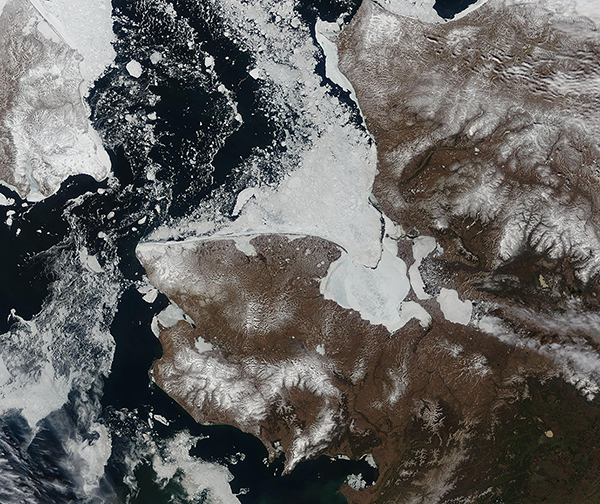Images
May 29, 2021 - Ice in Kotzebue Sound
Tweet
On May 26, 2021, the Moderate Resolution Imaging Spectroradiometer (MODIS) on board NASA’s Terra satellite acquired a true-color image of spring melt affecting the ice-filled waters between western Alaska, United States and Chukotka Autonomous Okrug, eastern Russia.
Bits of ice float freely in the mostly-open waters of the Bering Strait while fast ice clings to the Russian shoreline. Kotzebue Sound, situated between Seward Peninsula (south) and mainland Alaska (north) remains mostly ice-covered although a wide fracture indicating the start of melt appears near the town of Kotzebue.
The melt date of Kotzebue Sound is particularly important to the native people who rely on an persistent and reliable ice for ice fishing and seal hunting, which are vital for subsistence and their indigenous way of life. Elders in the town recall traditional ice melt dates much later than recent years, and ice as much as five feet thick not too many years ago. Early ice melts in recent years have severely limited fishing and hunting. In 2020 there were only five safe hunt dates in the spring. The thickness of winter ice, which may be as low as one foot in recent years, also shortens the season for ice fishing.
The retention of ice in Kotzebue Sound may bring a more favorable spring to the indigenous citizens of the region this spring. The Sea Ice Outlook for Western and Arctic Alaskan Coastal Waters published on May 27 by the National Weather Service, Anchorage, Alaska, states, “From the Bering Strait northward in to the Chukchi Sea, expect a more normal breakup, possible even a little delayed from the quicker breakups of the past few years.” The forecast for the Kotzebue Sound reads, “Sea ice within Kotzebue Sound may no longer be shorefast during the second week of June. Less than 3 tenths coverage is expected during the 4th week of June. Ice-free conditions are likely in the first week of July”.
Image Facts
Satellite:
Terra
Date Acquired: 5/26/2021
Resolutions:
1km (431.9 KB), 500m (3.9 MB), 250m (2.3 MB)
Bands Used: 1,4,3
Image Credit:
MODIS Land Rapid Response Team, NASA GSFC
Tweet
On May 26, 2021, the Moderate Resolution Imaging Spectroradiometer (MODIS) on board NASA’s Terra satellite acquired a true-color image of spring melt affecting the ice-filled waters between western Alaska, United States and Chukotka Autonomous Okrug, eastern Russia.
Bits of ice float freely in the mostly-open waters of the Bering Strait while fast ice clings to the Russian shoreline. Kotzebue Sound, situated between Seward Peninsula (south) and mainland Alaska (north) remains mostly ice-covered although a wide fracture indicating the start of melt appears near the town of Kotzebue.
The melt date of Kotzebue Sound is particularly important to the native people who rely on an persistent and reliable ice for ice fishing and seal hunting, which are vital for subsistence and their indigenous way of life. Elders in the town recall traditional ice melt dates much later than recent years, and ice as much as five feet thick not too many years ago. Early ice melts in recent years have severely limited fishing and hunting. In 2020 there were only five safe hunt dates in the spring. The thickness of winter ice, which may be as low as one foot in recent years, also shortens the season for ice fishing.
The retention of ice in Kotzebue Sound may bring a more favorable spring to the indigenous citizens of the region this spring. The Sea Ice Outlook for Western and Arctic Alaskan Coastal Waters published on May 27 by the National Weather Service, Anchorage, Alaska, states, “From the Bering Strait northward in to the Chukchi Sea, expect a more normal breakup, possible even a little delayed from the quicker breakups of the past few years.” The forecast for the Kotzebue Sound reads, “Sea ice within Kotzebue Sound may no longer be shorefast during the second week of June. Less than 3 tenths coverage is expected during the 4th week of June. Ice-free conditions are likely in the first week of July”.
Image Facts
Satellite:
Terra
Date Acquired: 5/26/2021
Resolutions:
1km (431.9 KB), 500m (3.9 MB), 250m (2.3 MB)
Bands Used: 1,4,3
Image Credit:
MODIS Land Rapid Response Team, NASA GSFC




